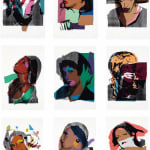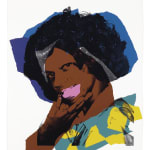

Andy Warhol 1928-1987
Warhol’s Ladies and Gentlemen portfolio, created in 1975, consists of ten screen prints (Feldman & Schellmann II.128–137) portraying anonymous Black and Latinx drag queens and trans women living and working in New York City. Commissioned by Italian art dealer Luciano Anselmino, the project was conceived as a counterpoint to Warhol’s more famous celebrity portraits—replacing recognisable faces with individuals marginalised from mainstream media.
The source photographs were taken by Warhol’s assistant, Bob Colacello, and photographer Paul Morrissey, in a series of impromptu Polaroid sessions. The resulting portraits were printed using Warhol’s silkscreen technique, the same method he had used to depict Marilyn Monroe, Liz Taylor, and Mao Zedong. In Ladies and Gentlemen, however, Warhol’s subjects are unnamed. The emphasis shifts from individual identity to performance, gesture, and presence—placing visibility at the centre of the work while resisting narrative interpretation.
This portfolio has since become one of Warhol’s most critically re-evaluated bodies of work. It is now recognised for its relevance to ongoing conversations around race, gender, and representation. At the time of its creation, the series received little public attention; today, it stands as a powerful exploration of image-making and social visibility.
Literature
Feldman & Schellmann II.128-137

